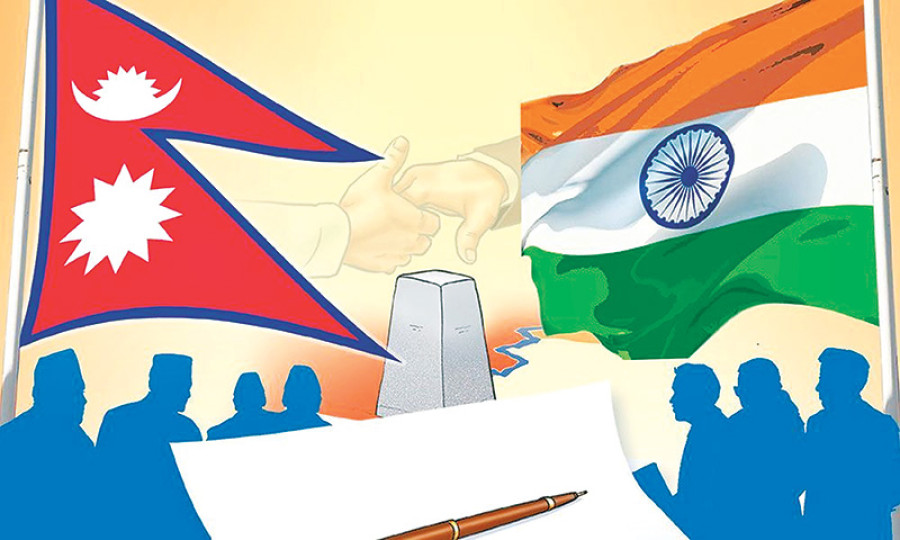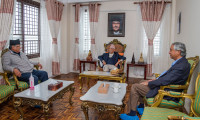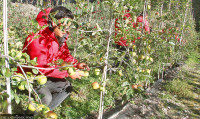National
Border row on agenda, but political talks likely to get more focus during Gyawali’s Delhi stay
The foreign minister is travelling to India on the heels of political turmoil caused by Oli’s decision to dissolve the House and declare snap polls for April 30 and May 10.
Anil Giri
Foreign Minister Pradeep Gyawali is travelling to New Delhi on Thursday, marking the first-ever high-level visit from Kathmandu to the south in over a year, amid signs of bilateral ties returning to track.
Gyawali is flying to Delhi to take part in the sixth meeting of the Nepal-India Joint Commission, which looks after the entire gamut of bilateral relations.
His visit, on the heels of political turmoil at home caused by Prime Minister KP Sharma Oli’s December 20 House dissolution move, is being closely watched in Kathmandu and Delhi.
Apart from regular bilateral issues as well as procurement of Covid-19 vaccines, Gyawali is expected to hold talks with the Indian leadership about the political situation in Nepal.
The Nepali side has said border row—Nepal and India are at loggerheads over Kalapani, Lipulekh and Limpiyadhura—will be a major issue during talks with the Indian side, but many say a headway is not likely for multiple reasons.
Gyawali is travelling to Delhi less than a month after Oli dissolved the House, thereby reducing his government to the caretaker status.
Caution has been advised from various sections not to reach any understanding on sensitive issues, not to sign any deal on issues that will have long-term repercussions and not to agree on any big-ticket projects as elections have been announced for April 30 and May 10.
Officials privy to the preparations of the visit say Nepal has a long list of agenda—getting Covid-19 vaccines in grants or procuring them at a subsidised rate from India, raising boundary disputes between the two countries and seeking India’s acknowledgement that boundary row is an issue.
“India seems to be open to discussing Covid-19 vaccine supply and bilateral cooperation when the foreign ministers of the two countries meet,” an official told the Post on condition of anonymity because he was not allowed to speak to the media. “On the boundary issue, Delhi might, at maximum, acknowledge Kathmandu’s concerns but it is most likely to keep it for further discussion later.”
There’s little likelihood of Delhi agreeing to reach a conclusion on the boundary row, as this is the first meeting at the foreign minister level ever since the dispute arose back in November 2019.
The meeting could agree to activate the foreign secretary-level mechanism constituted in 2014 during the Third Meeting of the Joint Commission in Kathmandu.
As per the agreement in 2014, the foreign secretary level mechanism would seek technical support from the Boundary Working Group in order to resolve the boundary disputes in Susta and Kalapani. Though the meeting at the foreign secretary level decided to set up such a mechanism to deal with boundary disputes between the two countries, not a single meeting has taken place in the last seven years.
The same meeting had formed the Boundary Working Group, which had been working at borders but due to the Covid-19 pandemic, it has halted its task since May last year. The Boundary Working Group has the mandate to construct, restore and repair boundary pillars including the clearance of no man’s land and carrying out other technical tasks.
At least two officials, one in Kathmandu and the other at the Nepali Embassy in Delhi, said both sides are likely to task the Boundary Working Group with providing technical inputs to the foreign secretary level mechanism.
“We are not expecting more than this when it comes to discussions on the boundary issues,” an official at the embassy told the Post over the phone seeking anonymity, citing the sensitivity of the matter.
Rajan Bhattarai, Oli’s foreign relations adviser, said it is too unrealistic to expect a conclusion on such sensitive issues like boundary from one meeting.
“On our behalf, we will raise the boundary issue during the meeting and we would seek an acknowledgement of the dispute from the Indian side,” Bhattarai told the Post.
Relations between Nepal and India started to sour after India in its new political map in November 2019 put Kalapani within its borders.
Delhi cold-shouldered Kathmandu’s calls for diplomatic dialogue. In May last year, India opened a road link via Lipulekh to Kailash Mansarovar in the Tibet Autonomous Region of China.
Nepal responded by publishing its own map depicting Kalapani, Lipulekh and Limpiyadhuara as parts of the Nepali territory resulting in the two countries entering a state of cartographic war, as both claimed the areas as their own. Bilateral ties between the two countries hit a rock bottom.
Dialogue at the highest level resumed in October after India’s foreign spy chief Samant Goel visited Kathmandu and met with Oli. In November, Indian Army Chief MM Naravane and Indian Foreign Secretary Harsh Vardhan Shringla came to Kathmandu in a span of three weeks.
But a month later, politics suddenly changed in Kathmandu.
Faced with a crisis in his own Nepal Communist Party, Oli decided to dissolve the House of Representatives on December 20.
Delhi so far has not made any other statement except saying it’s Nepal’s internal matter.
“We have noted the recent political developments in Nepal. These are internal matters for Nepal to decide as per its democratic process,” said Anurag Srivastava, spokesperson for India’s Ministry of External Affairs, on December 24. “As a neighbour and well-wisher, India will continue to support Nepal and its people in moving forward on the path of peace, prosperity and development.”
About a week before Oli dissolved the House, Vijay Chauthaiwale, who heads the foreign department cell of India’s governing Bharatiya Janata Party, was in Kathmandu to meet with the Nepali leadership, including Oli.
Political, diplomatic and strategic circles in New Delhi too are watching Gyawali’s visit with keen interest, as it is taking place after China’s unsuccessful attempts to save the Nepal Communist Party unity. China’s growing interest in Nepal’s politics over the last couple of years had caused concerns in Delhi.
Some say since Oli is now looking up to Delhi, Gyawali as his emissary is likely to seek the support of the Indian political leadership for Nepal’s House dissolution and the snap polls.
A Nepali diplomat, who spoke on condition of anonymity, said that naturally Gyawali will apprise the Indian leadership of the latest political situation in Nepal after the House dissolution.
The other faction of the Nepal Communist Party led by Pushpa Kamla Dahal and Madhav Kumar Nepal has taken to the streets, protesting against Oli’s House dissolution move. The Nepali Congress and the Janata Samajbadi Party too have objected to the House dissolution.
“Gyawali in Delhi is likely to justify why Oli dissolved the House and declared the polls,” said the diplomat. “He is also likely to seek support from India for holding the polls in April and May.”
Ranjit Rae, India’s former ambassador to Nepal, told The Print on Wednesday that Oli’s turned to India after he realised he was losing the Chinese support.
“After they [Chinese] started supporting unity of the [Nepal Communist] Party rather than the leadership and once Prime Minister Oli got a sense of this, that’s when he really turned to India,” said Rae. “Then there was a flurry of visits [from India].”
During his stay in Delhi, Gyawali is scheduled to meet with Indian Prime Minister Narendra Modi, Defence Minister Rajnath Singh, Home Minister Amit Shah and National Security Adviser Ajit Doval, among others.
Besides meeting with the top Indian leadership, Gyawali will also address a gathering at the Indian Council of World Affairs on Nepal-India relations, hold talks with Indian diplomats and experts, according to the Nepali Embassy in Delhi.
Before wrapping up his three-day visit, Gyawali will also speak to the Indian media.
Rae, the former ambassador, told the Post that the visit from Kathmandu formalises that the process of dialogue has begun at the bilateral level.
“I am sure the Nepali side will raise the boundary issue with India,” said Rae in a text message. “To resolve the boundary dispute and disagreement, we already have a mechanism. It can be activated. There are also mechanisms at the survey level, we can take support from them [as well].”
As far as Nepal’s political issues are concerned, India’s dilemma is likely to continue in the face of Oli’s move of House dissolution, which is being heard by the Supreme Court, and the declaration of snap elections, observers say.
“In the last few months and years, Nepal’s northern neighbour has become very visible and public,” Rae told The Print. “So all these factors led the government of India to conclude that it’s not a very good idea to have a very long gap in the engagement... at least on normal interaction and economic and other kinds of cooperation should continue. Hence there was this flurry of visits.”
“But now Prime Minister Oli has dissolved the House, and there is a big crisis in Nepal,” added Rae. “So this is the dilemma… if you don’t engage, there are problems. So I think we must continue our engagements. So you have to see Foreign Minister Gyawali’s visit in this context.”
Niahar Nayak, a fellow at Manohar Parrikar Institute for Defence Studies and Analyses in New Delhi, said that strengthening bilateral relations in the post-Covid-19 period, preliminary discussions on pending bilateral disputes, discussion on water, energy and trade and transit trade issues, among others, are expected during Gyawali’s visit.
“It looks like all bilateral issues and the status of Nepal-India ties, especially after Nepal unveiled its map, would be reviewed,” Nayak told the Post in a text message. “Most importantly, this visit [by Gyawali] indicates that the relationship is getting to normal. On boundary issues, very preliminary discussions are expected where the joint commission may activate the foreign secretary level mechanism.”




 6.64°C Kathmandu
6.64°C Kathmandu










%20(1).jpg&w=300&height=200)




